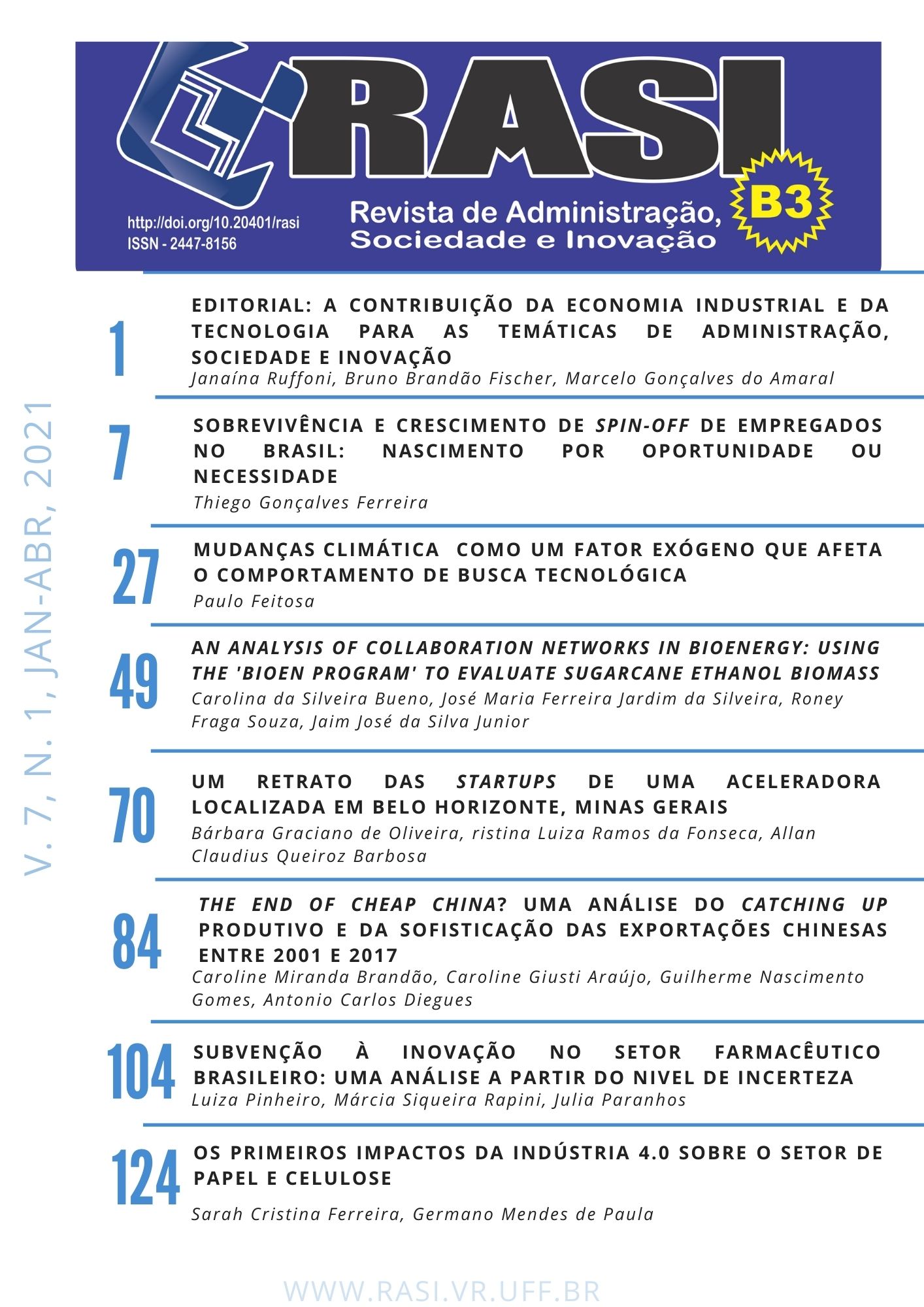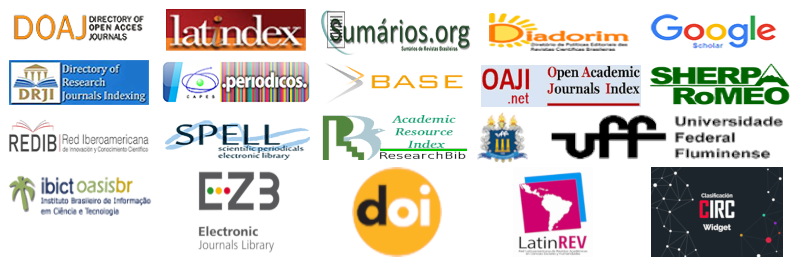The firsts impacts of Industry 4.0 on the Pulp and Paper sector
DOI:
https://doi.org/10.20401/rasi.7.1.522Keywords:
Industry 4.0, Pulp and Paper, InnovationAbstract
The purpose of this paper is to analyze the impacts of Industry 4.0 on the pulp and paper sector. The applied methodology consists in the identification of eight technological clusters and their first effects on the industry: internet of things, internet of things, intelligent and connected production, artificial intelligence, networking technologies, biotechnology and bioprocesses, nanotechnology, advanced materials and energy storage. Questionnaires were also applied to identify the influence of these innovations on the Brazilian reality. The results demonstrate the diffusion and importance attributed to these technologies in the sector in 2017, in 2022 and in 2027.
Downloads
References
Aires, R. W. A., Moreira, F. K., Freire, P. S. (2017). Indústria 4.0: desafios e tendências para a gestão do conhecimento. SUCEG-Seminário de Universidade Corporativa e Escolas de Governo, 1(1), 224-247.
Andrade, P. S. A. D. M. (2017). A Quarta Revolução Industrial e sua relação com a produtividade atual: uma revisão da literatura. (Monografia) UnB: Brasília.
Berg, P., Lingqvist, O. (2017). Pulp, paper, and packaging in the next decade: Transformational change. McKinsey: Stockholm.
Biazus, A., Hora, A. B. D., & Leite, B. G. P. (2010). Panorama de mercado: celulose. In: BNDES Setorial, 32, 311-370.
BNDES. (2012). BNDES 60 anos: perspectivas setoriais. BNDES: Rio de Janeiro.
CEPI. (2015). Paper Industry 4.0: What Digital Can Do For The Paper Industry. CEPI: Brussels.
Conceição, O. A. C. (2000). A centralidade do conceito de inovação tecnológica no processo de mudança estrutural. Ensaios FEE, 21(2), 58-76.
Correa, D. V. G. (2018). Celulose: logística e distribuição internacional. SESI SENAI Editora.
Coutinho, J. (2006). Materiais de mudança de fase para isolamento térmico e armazenamento de energia. Engenharia Química, 2, 4-6.
De Paula, G. M. (2018). Nota Técnica do Sistema Produtivo Insumos Básicos e Foco Setorial Siderurgia. Relatório do Projeto Indústria 2027: Riscos e Oportunidades para o Brasil Diante de Inovações Disruptivas. IE-UFRJ: Rio de Janeiro; IE-UNICAMP: Campinas.
FAO. (2020). FAOSTAT-Forestry database. FAO: Rome.
Florêncio, M. N. S., Miranda, D. P. S. L., Santos, A. C., Dias, C. T., Russo, S. L., de Oliveira Júnior, A. M. (2017). Prospecção Tecnológica: um estudo sobre os depósitos de patentes em nanobiotecnologia. Cadernos de Prospecção, 10(2), 315. Doi:
DOI: 10.9771/cp.v10i2.21453
Freitas, A. D. A. (2017). A internet das coisas e seus efeitos na indústria 4.0. (Monografia) UFF: Niterói.
Galindo-Rueda, F.; Verger, F. (2016).OECD Taxonomy of Economic Activities Based on R&D Intensity", OECD Science, Technology and Industry Working Papers, 2016/04, OECD Publishing, Paris. Doi: 10.1787/5jlv73sqqp8r-en.
GTAI. (2014). Industrie 4.0: Smart manufacturing for the future. GTAI, Berlin.
Hermann, M., Pentek, T., Otto, B. (2016). "Design Principles for Industrie 4.0 Scenarios,"49th Hawaii International Conference on System Sciences (HICSS), Koloa, pp. 3928-3937. Doi: 10.1109/HICSS.2016.488.
Hora, A. B.; Ribeiro, L. B. N. M.; Mendes, R. (2018). Papel e celulose = Paper and cellulose. In: Visão 2035: Brasil, país desenvolvido: agendas setoriais para alcance da meta. pp. 119-142.
Huang, J. (2017). Sustainable Development of Green Paper Packaging. Environment and Pollution, 6(2), 1-7.
IBÁ. (2020). Relatório 2019. IBÁ: São Paulo.
IEDI. (2017). Indústria 4.0: A Quarta Revolução Industrial e os Desafios para a Indústria e para o Desenvolvimento Brasileiro. IEDI: Brasília.
IEL. (2017). Mapa de clusters tecnológicos e tecnologias relevantes para competitividade de sistemas produtivos. IEL/NC: Brasília.
Jones, P., & Comfort, D. (2017). The forest, paper and packaging industry and sustainability. International Journal of Sales, Retailing and Marketing, 6(1), 3-21.
Karlovi?, I. (2017). Technologies for using big data in the paper and printing industry. J. Print Media Technol. Res, 6(2), 75-84.
Laestadius, S. (1998). The relevance of science and technology indicators: the case of pulp and paper. Research Policy, 27(4), 385-395. Doi: 10.1016/S0048-7333(98)00050-X
Martin, C. (2017). Indústria 4.0 Aponta Caminhos para Chegar à Fábrica Do Futuro: Máquinas Inteligentes e Comunicação Entre Processos Serão Novo Padrão dos Parques Fabris de Celulose e Papel. O Papel, 78(4).
Martins, N. F. S. (2018). Estudo das vantagens da aplicação de metodologias, indústria 4.0, no contexto industrial (Dissertação) ISEP: Porto.
OCDE. (2017). OECD Science, Technology and Industry: Scoreboard 2007. OCDE: Paris.
Ojala, J., Lamberg, J. A., Peltoniemi, M., Särkkä, T., & Voutilainen, M. (2013). A evolução da indústria de papel global. O Papel, 74(9).
Ojala, J., Voutilainen, M., & Lamberg, J. A. (2012). The evolution of the global paper industry: concluding remarks. In: The Evolution of Global Paper Industry 1800 – 2050 pp. 345-363.
Peixoto, J. A., Pereira, L. M. (2018). Industria 4.0 na auto-organização dos sistemas produtivos. Revista Eletrônica Científica Da UERGS, 4(3), 525-538. Doi: 10.21674/2448-0479.43.525-538
Perez, C. (2010). Technological revolutions and techno-economic paradigms. Cambridge journal of economics, 34(1), 185-202. Doi: 10.1093/cje/bep051
Pinho, M., Avellar, A. P. M. (2002). Economia de escala, barreiras à entrada e concentração na indústria de celulose e papel. Encontro Nacional de Engenharia de Produção, 22, 1-8.
Piotto, Z. C. (2003). Eco-eficiência na indústria de celulose e papel-estudo de caso. (Tese) Usp: São Paulo.
PwC. (2016). Industry 4.0: Building the digital enterprise. PwC: Munich.
Santi, T. (2018). Negócios e mercado: Segurança cibernética na indústria 4.0. O Papel. 79(2), 59-60.
Santos, B. P.; Alberto, A.; Lima, T. D. F. M.; Charrua-Santos, F. M. B. (2018). “Industry 4.0: Challenges and Opportunities”, Revista Produção e Desenvolvimento, 4(1), 111-124. Doi: 10.32358/rpd.2018.v4.316
Schwab, K. (2019). A quarta revolução industrial. Edipro: São Paulo.
Shaikh, F. K., Zeadally, S., & Exposito, E. (2015). Enabling technologies for green internet of things. IEEE Systems Journal, 11(2), 983-994. Doi: 10.1109/JSYST.2015.2415194
Downloads
Published
Issue
Section
License
Copyright (c) 2020 Review of Administration, Society and Innovation

This work is licensed under a Creative Commons Attribution 4.0 International License.
RASI, in accordance with Law No. 9,610 of February 19, 1998, which amends, updates and consolidates Brazilian copyright law and makes other provisions, adopts the following conditions of the Copyright Assignment:
1. RASI maintains, with the transfer of copyrights, the possession of rights over the content published;
2. The author retains his moral rights of the content, including the right to be identified as the author whenever the content is published;
3. Despite the attribution of copyright, the author retains the right to reuse the material in future collections of his own work without encumbrance. The acknowledgments of the previous publication in the RASI are the only requirements in such cases;
4. The author may make photocopies of the content, or distribute it by electronic mail or fax, provided that they are intended for their own classes and for the purpose of meeting research objectives, provided that: (a) such copies are not resold and (b) reference to the original source of the publication and the name of the RASI are clearly indicated on all copies made of the document.











